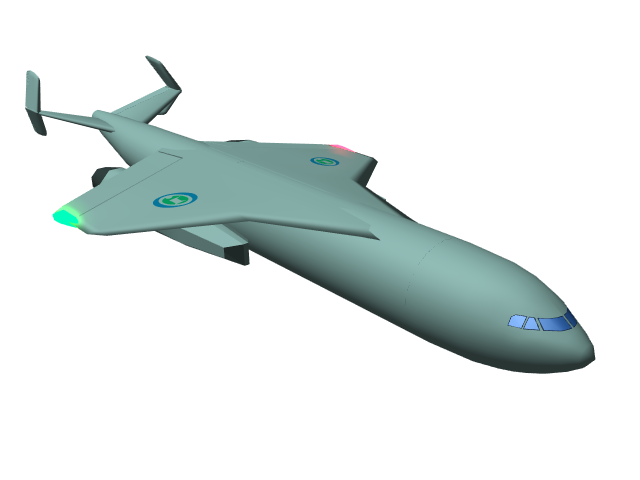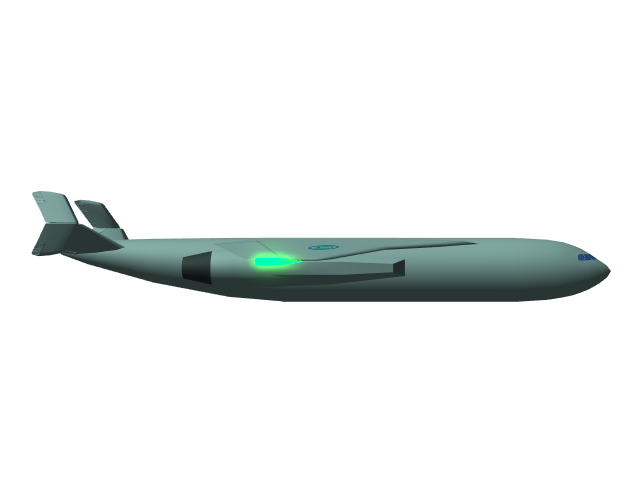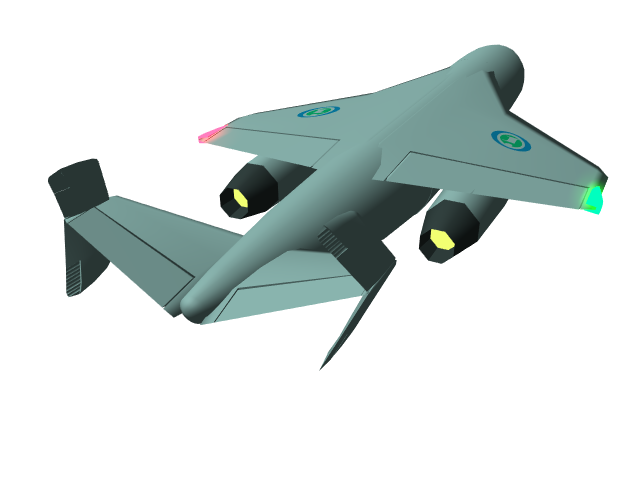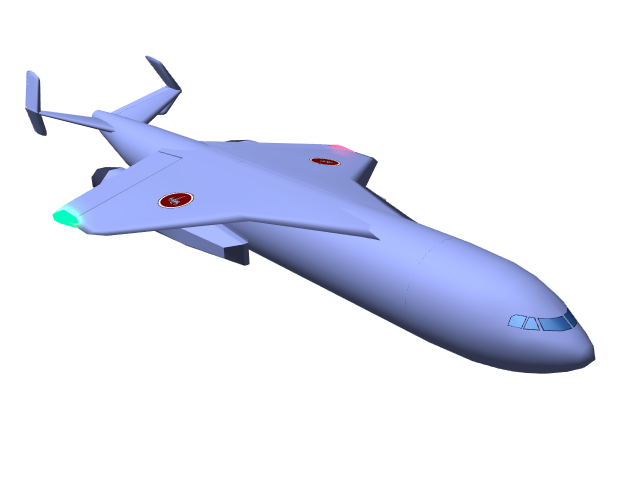Table of Contents
Starliner
The Starliner is exactly what it sounds like, a Starliner. It is a passenger-carrying FTL craft made specifically to get large groups of People from point A to point B. As an added bonus, the Starliner is capable of efficiently transporting groups of people within the atmosphere of a planet.
About the Ship
The Starliner was built to be an efficient, inexpensive craft for ferrying large amounts of people and some supplies over a great distance, whether it be intercontinental, or intergalactic in scale.
Key Features
Capability for both Intercontinental, and intergalactic transport.
Mission Specialization
The Starliner excels at carrying large amounts of people long distances quickly and efficiently.
Appearance
The ship is shaped like a long rounded off rectangle, with tapered ends. starting near the middle is a pair of swept-back wings from which hang engine pods. to the rear are the tail surfaces, with the horizontal surfaces ending in vertical stabilizers, below the rear stabilizers are the main power generation and FTL engines.
History and Background
The Starliner was created for a number of reasons, all of which had to do with Mass transit, which was practically unavailable to the public at inexpensive prices. The only commonly available form of Mass Transit was Cruising, an expensive, extravagant pastime that most people could not afford, or did not want to deal with when traveling. The other available form of transportation, besides private star craft, is the use of Shuttles, a slow, and sometimes dangerous route to take, as well as one that could not take very many at once. Taking a cue from Intercontinental Airliners used on some planets, Origin Industries created the Starliner, and Intergalactic mass transport that is efficient, fast, and cost-effective, both for its operators and patrons.
Statistics and Performance
General
Class: OI-Y1-1A Type: Passenger liner Designers: Origin Industries Manufacturer: Origin Industries, Dawn Station Production: mass-produced Fielded by: Civilian organizations, Star Army of Yamatai Price: 65,000
Passengers
Crew: 45 (5 Bridge, 40 Attendants) operators are recommended, 3 are required. Maximum Capacity: There are accommodations for about 1,900 people. About 3,500 people can fit aboard in an emergency, but the ship would be extremely cramped.
Dimensions
Length: 200 meters Width(body): 20 meters width(full): 100 meters Height: 30 meters Decks: 3 (7 meters each)
Propulsion and Range
Continuum Distortion Drive: 12,000c Hyperspace Fold Drive: .5 ly/min Sublight Engines: .15c (~44,968 kilometers per second) (~27,942 miles per second) In Atmosphere: 1,000 MPH Range: Up to one Week of fuel. Lifespan: 50 years Refit Cycle: Yearly
Damage Capacity
See Damage Rating (Version 3) for an explanation of the damage system.
- Hull: 12 SP
- Shields: 10 (Threshold 1)
Inside the Ship
Deck Layout
The upper two decks are very similar, but staggered slightly, with the lower of the two slightly forward of the upper. They both end in doorways that lead into the bridge, which is split between the two decks. The third deck is cargo-only, and spans the entire bottommost section of the ship.
Compartment Layouts
The two passenger cabins each hold 999 seats, and give passengers comfortable seats, which can recline partway to aid sleeping. The back of each seat contains a tray and a small view-screen for the passenger behind, with the trays and screens of the front rows simply mounted on the walls. Every seat is a first-class seat, and is capable of being adjusted for the user's comfort. There are Three Aisles running down the length of the ship, one down the center and two partway to either side, each is one meter wide, helping allow access to the seats, which are placed 12 abreast, three between each aisle, and the walls. Bisecting each of the passenger cabins cabins is a station for the Attendants. Above each seat are small controls which allow each passenger to control personal lighting, an small air jet for cooling, and a call button for an attendant. Built into every seat is a small headphone jack, which allows headphones to be plugged in so a passenger can listen to on-board movies or music channels. Each ship usually has a selection of 30 current and classic movies, as well as over 200 music channels, which can be sorted though via an interface on the view-screen.
There are 83.3 rows, with 12 seats per row. The 84th row only has four seats.
Bridge
The Bridge is basically an Deluxe Bridge, but different in the fact that it is two levels, which are separated by stairs and a set of railings. The two-deck bridge is open, allowing communication between the two sections. The bridge also contains a closet with EVA suits for the crew, in the case of a hull breach, which gives them the chance to repair the damage.
Cargo Storage Areas
The Bottommost level of the starliner is a huge storage compartment, meant to carry whatever luggage the passengers may have, but can also be used to carry small cargo, mail, and sometimes extra supplies for a trip.
The Cargo area has the volume to carry 735 Medium Standard Starship Cargo Containers
Carry-on Compartments: Overhead compartments in the passenger cabins allow passengers to bring small amounts of stuff with them, for easy access during flights. These allow for about 6 cubic feet of cargo space per person on the ship, and line the ceilings.
Engineering
In the rear of the ship, on all three decks, connected by a spiral staircase, is the engineering section, which allows access to the generators and FTL engines, as well as to several vital control stations. in the event that the bridge is damaged, the ship may be flown from here.
Maintenance Conduits
There are maintenance conduits in the wings, which allow engineers access to the engines. They are reached by hatches in the ceiling of the upper passenger compartment.
Attendant's prep chambers
Compartments which split each deck in half, they contain small carts which can be used to deliver the food stored within, as well as prepare it if need be. These chambers contain storage for all of the on-board amenities such as pillows, blankets, headsets, and drinks. The Attendant's prep chambers can be used as emergency medical centers, but are little more than first-aid stations. These chambers also contain seating for the attendants.
Restrooms
Located next to the Attendant prep chambers, as well as at either end of the cabin, there are small bathrooms. One on either side of each of the three aisles, six on either side of the attendant chamber, making for a total of 12 at each chamber. At the ends of the cabins are six more, giving each cabin deck a total of 24 restrooms, and a total of 48 for the entire ship. These restrooms are small and have only enough room for one person. they each contain a toilet, a small sink, a trash can, and all the necessary supplies for use.
Ship Systems
Airlock Doors
Placed at intervals along the ship are airlock doors which allow the starliner to dock with stations as well as other ships. These doors are used for the loading and unloading of passengers, as well as crew. The bottom level has larger doors which allow for cargo to be loaded and unloaded. Doors on the cabin levels are located at: just behind the bridge on either side, just before and just after the Attendant stations on either side, and just fore of the engineering sections on either side, as well as midways between the Engineering and Attendants stations, on either side, and midway between the attendant station and bridge on either side.
Hull and Hull Integrated Systems
The entire ship is made of Durandium Alloy. On the underside of the Hull is a retractable undercarriage which contains landing gear for landing on planets.
Computers and Electronics
The Starliner sports a Destiny AI Knight Suite, which provides for all the computing and sensing needs of the Stariner.
Emergency Systems
- There is a fire suppression system built into the ship which can help during an on-board fire
- There are emergency “Life vests” In the seats, which are automatically deployed atmospheric containment units built into every seat, that activate in the event of a hull breach or loss of atmosphere. These consist of a polymer bubble that forms around the seat, hardening to contain atmosphere. The Bubbles are connected to the life support system, keeping the occupant alive for as long as the ship provides power to life support. In the event life support shuts off, the bubble can contain a passenger for 30 minutes before air runs out.
- In the event of an emergency, passengers should stay seated unless otherwise directed by the crew. If there is a hull breach, the life bubbles will activate, keeping them in place until an atmosphere is restored, at which point they deflate and contract into storage. If the ship must be evacuated, passengers are to file out of whichever door is nearest them, but in a vacuum, they may only use doors that have confirmed atmosphere on the other side, meaning they are docked with a rescue craft.
Life Support Systems
Environmental recycling system The ERS is just a simple yet effective filtration system, which filters water and air, purifying it so it may be reused. Filters must be replaced after 5 years of continuous operation.
AC system A simple climate control system, it allows for cabins to be kept at a specific temperature. Controls are located in each cabin.
Unidirectional Gravitational Plating: Plating on the roof emits a pseudo-gravitational field that is attracted to the plates on the floor pushing everything on the ship 'down'. This creates the false sense of gravity that permeates the ship.
Propulsion
FTL Propulsion:Continuum Distortion Drive Hyperspace Fold Drive: This ship has a basic Fold Drive, for use in Inter-stellar travel. The fold bubble is incapable of “towing” anything larger than a shuttle along with the ship. STL Propulsion: The Starliner uses several Ion thrusters for STL propulsion. These particular thrusters have very low acceleration and top speed, but are very efficient. The Ion thrusters on the wings may be pivoted in limited arcs to allow for maneuvering in vacuum.
Power
The Starliner uses a fusion reactor, which uses Deuterium as its fuel. Running on normal power, the Starliner can carry enough fuel for up to a week of activity.
Shield Systems
The ship uses a fairly simple shielding system to protect the ship and its inhabitants from the harsh elements of space, such as radiation and debris. This is the default shielding for the ship, and is usually turned on all the time. This shield is contained in a small blister on the underside of the nose. DR 1
| Products & Items Database | |
|---|---|
| Product Categories | starships |
| Product Name | Starliner |
| Nomenclature | OI-Y1-1A |
| Manufacturer | Origin Industries Fleet Yards |
| Year Released | YE 32 |
| Price (KS) | 65 ,000.00 KS |
| Star Army Logistics | |
|---|---|
| Supply Classification | Class A - STARSHIPS |



